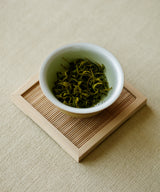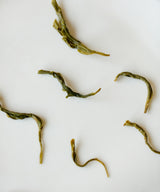Laoshan Green 2025
崂山绿茶
Harvest
May 10 - May 20, 2025
Origin
Laoshan, Qingdao
Another year of this impeccable, full bodied green tea from one of our favourite producers in Laoshan.
This harvest is very balanced in its qualities: it is as refreshing as it is rich, and as salty as it is sweet. Its champagne colour liquor has a rich, nutty aroma and an oceanic, umami forward taste. On the finish we find a light, uplifting astringency with a honeyed cereal undertone. The balancing act this tea performs gives this harvest a very satisfying fullness. It will be enjoyed by those who like a stronger tasting green tea that isn’t too cooling.
. . .
Mr. Tang’s family are generational tea farmers in Laoshan Mountain of Qingdao, Shandong. Shandong is located in Northeastern China. It is named after Mount Lao, a magnificent mountain range recognized by its striking, slim, elongated cliffs.
The many small plots that make up Mr. Tang’s tea farm are scattered along this coastline, at the foot of Mount Lao. Some are distributed right along the beaches, exposed to the salty wind that blows off of the water, while others are tucked slightly up into the forested hills, protected by the pine trees and the mountain behind them. There is a great peace that settles over this area of Laoshan. The tranquility of Mr. Tang’s tea farm is resounding, and extends between its many parts. Following a path that connects the plots next to the ocean to the ones tucked away in the forest, the sound of the waves progressively gives way to the sound of forest birds and running springs and the scent of the ocean turns into the scent of red pines and green plum.
Laoshan is a very unique tea producing area in China. It is as far North as a tea region can be, and at the highest latitude before temperatures become too cold for tea trees to survive. The small farms in Laoshan have Mount Lao on one side, and are otherwise surrounded by ocean. The air is very humid, and it sees longer winters with more frost and snow than tea regions further South. Another special feature of Laoshan is that the water which irrigates the tea trees comes from natural springs that run through Mount Lao. This water is very pure and high in the minerals it collects from the cliffs of the mountain. It is no wonder we find that teas from Laoshan have such a distinct taste when compared with teas from Southern China. The mountain minerals and the constriction that comes with cooler temperatures give these teas a great richness, and the wet air coming off of the ocean has imparted umami and an unmistakable saline taste to them.
Because of the colder climate, the first harvest of Laoshan green tea is almost a month later than the first harvest of green teas from tea regions in Southern China. When the time comes, the leaves are hand harvested by Mr. Tang’s mother and grandmother, from their tea gardens that are scattered between Mount Lao and the Yellow Sea. Mr. Tang’s father and uncles, generational craftsmen who make this tea, have pan-fried it by hand in small batches in a charcoal-fired wok.
. . .
Brewing guide
| Tea | 3g |
|
Temperature |
80 °C |
| Water | 120ml |
| Steep time | 10 - 90 sec |
| No. of infusions | 4 |












